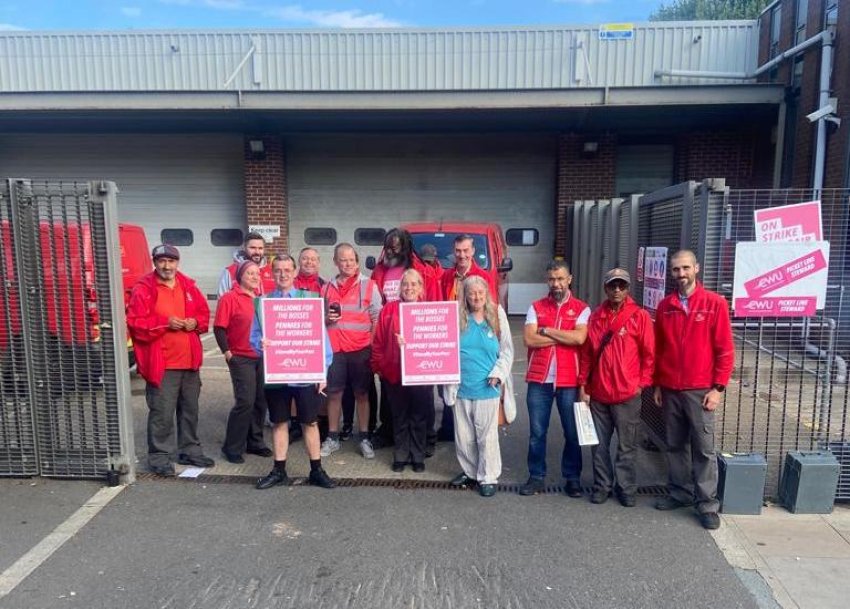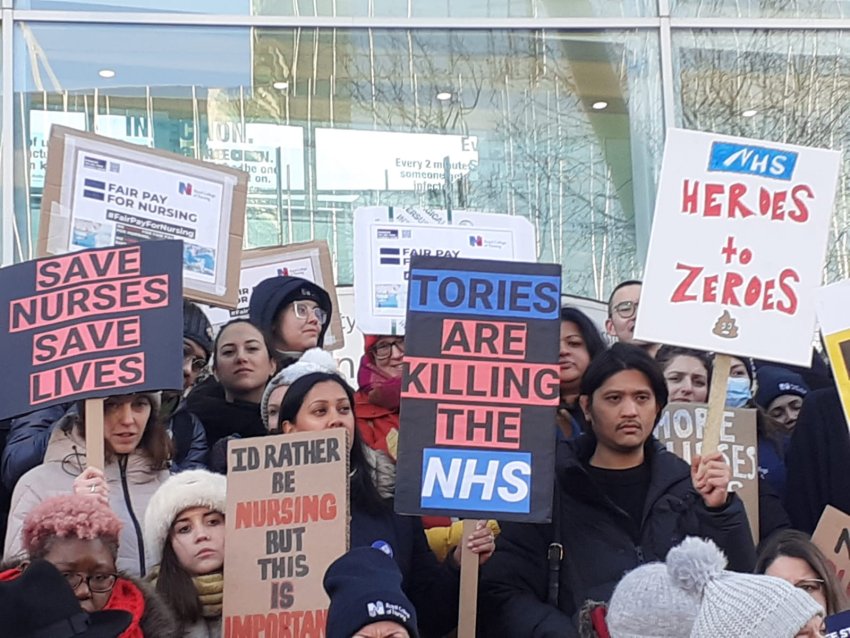Source >> green left
Teachers are on rolling strikes from February 28 across England, and up to 100,000 unionists from across the public sector are planning industrial action on March 15 (Budget day). What are workers demanding and how significant is this strike wave?
Strike action has been taking place intermittently since last June: particularly by rail and mail workers, university and college lecturers, civil servants and more recently in parts of the health service and schools.
Rail and mail are mostly privatised – but they are places in which governments have more impact in negotiations than in other parts of the economy. A public service ethos is also expected by both workers and users. So while pay is central, service delivery is also an issue. So, for example, when the bosses talk about the need to drive up productivity in order to fund a pay rise – not that they are keen to give much ground there – the unions respond that job cuts threaten health and safety and, in particular, to the rights of many disabled people who need assistance to use inaccessible trains. For education and health unions these issues are even more central to the disputes – and to the level of public support they attract.
Levels of industrial action across Britain have been incredibly low since the defeat of the emblematic 1984‒85 Miners’ strike by Margaret Thatcher’s government. Many of the workers striking over recent months have never witnessed successful trade union action – never mind actively participated in it.
The peak of action thus far was on February 1, with more trade unionists in Britain on strike on any single day than for decades. Around half a million workers from six major trade unions came out in the first serious attempt at cross industry co-ordination since the strikes started last June. But there were a million workers who could have legally been called out that day – who had an existing mandate to strike – so this action only reached half its potential.
March 15 looks uneven because there is a contradictory situation. However, there is some good news. The civil service union brought out members in 124 departments on February 1. They missed the turnout threshold — dictated by Britain’s extremely reactionary anti-union laws — in nine other departments by narrow margins. They re-balloted in those departments and succeeded, so on March 15 an extra 33,000 members will be striking.
The two major unions on the London Underground are striking on the day, meaning that the tube network will be shut down – and protesters from across the capital will cram onto buses to join those coming on coaches from outside town for the central rally.
Perhaps the most exciting new element is the junior doctors – a confusing term which covers doctors who have qualified up to 20 years ago. Over 35,000 of them voted overwhelmingly for strike action and immediately announced they would take a 72-hour all out strike ending in the early morning of March 16.
But at there has also been fragmentation in three areas: higher education, mail and much of the health service.
On February 17 University and College Union (UCU) General Secretary, Jo Grady announced that planned strike action would be paused for intensive negotiations. She did so unilaterally with no consultation – and without showing any concrete progress in the management offer. Furious members and activists have been presented with a fait accompli.
Postal workers have not been on strike since before Christmas – after 18 days of action earlier. A re-ballot took place with a majority of 96.9% for further action. A number of workplace reps have been victimised and managers are imposing new working patterns – a significant aspect of the dispute in the first place. Despite this, the union leadership and management issued a joint statement on March 2. Officials claim that further changes will not go ahead without consultation – but this could easily be used to tie workplace reps into policing rotten deals. There is a lot of anger, but no real forum for activists to fight for an alternative strategy.
In health, there are two main areas where industrial action has been already been taking place – amongst nurses and in the ambulance service. The main union involved in the former is the Royal College of Nursing (RCN), which until recently had a ban on taking industrial action, but starting striking in December 2022. It was clear from the beginning their leadership wanted the nurses to be treated as a special case. They stayed well clear of holding action on February 1. So it was no big surprise when they announced on February 22 they were in discussions with the government. Not unexpectedly, since then we have heard nothing of what might be on offer.
In the last week, ambulance workers have agreed to talks and called off action. What seems to be on offer is a one-off payment for last year’s pay – which does nothing to combat the real term pay lost over the last decade.

How deep is the coast of living/wages crisis in Britain? What is its impact on ordinary people?
There are different elements to the “cost of living” crisis. For most of the strikers the real value of their wages has fallen over a decade or more. Services have been undermined by privatisation and casualisation, meaning workers and users have long term grievances.
Rampant inflation formally rose last autumn to more than 11% — but with an even worse impact on working-class living standards. Basic foodstuffs, fuel and housing costs make up the most significant elements of this.
Many have been faced with hardships – with a choice between heating and eating. Food bank use has soared to a level where one in five people in work are using them!
This is a major reason why the strikes have very wide public support. This is particularly true of health service workers. A huge majority of people are desperate to see proper funding for the National Health Service, an end to privatisation and decent pay to end the situation where, for example, nurses are leaving to work in supermarkets to earn a higher hourly rate there.

What has been the response of the Rishi Sunak government to workers’ demands so far? What will it take to force their hand?
This has been a time of political turmoil with three different Tory Prime Ministers – Boris Johnson, Liz Truss and now Sunak. Initially all adopted a hands-off approach – while using the mainstream media to blame wage inflation for the cost of living crisis.
Once it became clear that the unions were not backing down, they shifted tack. Despite Britain having the most repressive anti-union laws already, they started to introduce a ‘minimum service level bill’ which would force many to work even though they voted to strike. The irony is that those levels are often not met even when there are no strikes – so they certainly aren’t winning any popularity contests with this. They have also begun to tempt some union leaderships into talks which don’t address the real concerns that led to the disputes in the first place.
The political geography of these strikes is complicated – different unions organise across different countries – Scotland, Wales, Ireland as a whole and sometimes the north of Ireland as well as England. While the Tories are in government in Westminster, in Edinburgh there is an SNP government and in Cardiff a Labour government — both of which have made separate and better offers to some workers whose pay bills come from their budgets.
Does this industrial wave have the potential to sprout a political movement that could challenge the parties of austerity and privatisation? What posture is the Kier Starmer Labour party adopting towards it? What are the prospects for uniting the left around such a project?
Starmer’s position has been appalling – forbidding members of his Shadow Cabinet from joining picket lines. In so far as he has mentioned worker’s grievances he has emphasised how fiscally responsible Labour in government would be.
Some unions made moves to set up a broader political campaign going beyond workplace issues to broader questions like housing and the right to food. However this withered on the vine because it lacked democratic structures that could bring together those with the commitment to build it. Strike solidarity committees have developed in some areas, but these do not have a wide political agenda.
Whether any of this is could contribute to the development of a new political party is something I can’t possibly address in this article.
Art Book Review Books Campism Capitalism China Climate Emergency Conservative Government Conservative Party COVID-19 Creeping Fascism Economics EcoSocialism Elections Europe Far-Right Fascism Film Film Review Fourth International France Gaza History Imperialism Iran Israel Italy Keir Starmer Labour Party Long Read Marxism Marxist Theory Migrants Palestine pandemic Police Protest Russia Solidarity Statement Trade Unionism Trans*Mission Ukraine United States of America War

